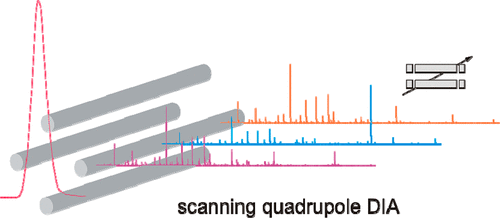当前位置:
X-MOL 学术
›
J. Proteome Res.
›
论文详情
Our official English website, www.x-mol.net, welcomes your feedback! (Note: you will need to create a separate account there.)
Scanning Quadrupole Data-Independent Acquisition, Part A: Qualitative and Quantitative Characterization
Journal of Proteome Research ( IF 4.4 ) Pub Date : 2017-12-29 00:00:00 , DOI: 10.1021/acs.jproteome.7b00464 M. Arthur Moseley 1 , Christopher J. Hughes 2 , Praveen R. Juvvadi 3 , Erik J. Soderblom 1 , Sarah Lennon 2 , Simon R. Perkins 4 , J. Will Thompson 1 , William J. Steinbach 3, 5 , Scott J. Geromanos 6 , Jason Wildgoose 2 , James I. Langridge 2 , Keith Richardson 2 , Johannes P. C. Vissers 2
Journal of Proteome Research ( IF 4.4 ) Pub Date : 2017-12-29 00:00:00 , DOI: 10.1021/acs.jproteome.7b00464 M. Arthur Moseley 1 , Christopher J. Hughes 2 , Praveen R. Juvvadi 3 , Erik J. Soderblom 1 , Sarah Lennon 2 , Simon R. Perkins 4 , J. Will Thompson 1 , William J. Steinbach 3, 5 , Scott J. Geromanos 6 , Jason Wildgoose 2 , James I. Langridge 2 , Keith Richardson 2 , Johannes P. C. Vissers 2
Affiliation

|
A novel data-independent acquisition (DIA) method incorporating a scanning quadrupole in front of a collision cell and orthogonal acceleration time-of-flight mass analyzer is described. The method has been characterized for the qualitative and quantitative label-free proteomic analysis of complex biological samples. The principle of the scanning quadrupole DIA method is discussed, and analytical instrument characteristics, such as the quadrupole transmission width, scan/integration time, and chromatographic separation, have been optimized in relation to sample complexity for a number of different model proteomes of varying complexity and dynamic range including human plasma, cell lines, and bacteria. In addition, the technological merits over existing DIA approaches are described and contrasted. The qualitative and semiquantitative performance of the method is illustrated for the analysis of relatively simple protein digest mixtures and a well-characterized human cell line sample using untargeted and targeted search strategies. Finally, the results from a human cell line were compared against publicly available data that used similar chromatographic conditions but were acquired with DDA technology and alternative mass analyzer systems. Qualitative comparison showed excellent concordance of results with >90% overlap of the detected proteins.
中文翻译:

扫描四极杆数据无关的采集,A部分:定性和定量表征
描述了一种新颖的与数据无关的采集(DIA)方法,该方法在碰撞单元前方装有扫描四极杆和正交加速飞行时间质量分析仪。该方法已被表征用于复杂生物样品的定性和定量无标签蛋白质组学分析。讨论了扫描四极杆DIA方法的原理,并针对多种复杂度不同的模型蛋白质组,针对样品复杂度优化了分析仪器的特性,例如四极杆透射宽度,扫描/积分时间和色谱分离动态范围包括人体血浆,细胞系和细菌。另外,对现有DIA方法的技术优点进行了描述和对比。说明了该方法的定性和半定量性能,可使用非针对性和针对性的搜索策略对相对简单的蛋白质消化混合物和特征明确的人细胞系样品进行分析。最后,将人类细胞系的结果与使用相似色谱条件但通过DDA技术和替代质量分析仪系统获得的公众可获得的数据进行比较。定性比较显示结果具有极佳的一致性,检测到的蛋白质> 90%重叠。将人类细胞系的结果与使用相似色谱条件但通过DDA技术和替代质量分析仪系统获得的公开数据进行了比较。定性比较显示结果具有极佳的一致性,检测到的蛋白质> 90%重叠。将人类细胞系的结果与使用相似色谱条件但通过DDA技术和替代质量分析仪系统获得的公开数据进行了比较。定性比较显示结果具有极佳的一致性,检测到的蛋白质> 90%重叠。
更新日期:2017-12-31
中文翻译:

扫描四极杆数据无关的采集,A部分:定性和定量表征
描述了一种新颖的与数据无关的采集(DIA)方法,该方法在碰撞单元前方装有扫描四极杆和正交加速飞行时间质量分析仪。该方法已被表征用于复杂生物样品的定性和定量无标签蛋白质组学分析。讨论了扫描四极杆DIA方法的原理,并针对多种复杂度不同的模型蛋白质组,针对样品复杂度优化了分析仪器的特性,例如四极杆透射宽度,扫描/积分时间和色谱分离动态范围包括人体血浆,细胞系和细菌。另外,对现有DIA方法的技术优点进行了描述和对比。说明了该方法的定性和半定量性能,可使用非针对性和针对性的搜索策略对相对简单的蛋白质消化混合物和特征明确的人细胞系样品进行分析。最后,将人类细胞系的结果与使用相似色谱条件但通过DDA技术和替代质量分析仪系统获得的公众可获得的数据进行比较。定性比较显示结果具有极佳的一致性,检测到的蛋白质> 90%重叠。将人类细胞系的结果与使用相似色谱条件但通过DDA技术和替代质量分析仪系统获得的公开数据进行了比较。定性比较显示结果具有极佳的一致性,检测到的蛋白质> 90%重叠。将人类细胞系的结果与使用相似色谱条件但通过DDA技术和替代质量分析仪系统获得的公开数据进行了比较。定性比较显示结果具有极佳的一致性,检测到的蛋白质> 90%重叠。


























 京公网安备 11010802027423号
京公网安备 11010802027423号